Choosing the Right Paint for Bathroom Tiles


Intro
When it comes to refreshing a bathroom, the right paint can make all the difference, especially when dealing with tiles. Painting bathroom tiles is not just an aesthetic enhancement; it offers a simple, cost-effective way to completely transform the feel of the space. This guide will take you on a journey through the process of optimal paint selection, exploring essential factors to consider and giving you the tools to achieve a salon-quality finish.
Understanding how bathrooms are uniquely different from other rooms can guide your paint choices. With the lingering humidity and frequent water exposure, you need to take a moment to think carefully about your options. This article aims to arm homeowners—whether seasoned DIY enthusiasts or first-timers—with the necessary knowledge to make wise decisions for their tile-painting project.
This will cover not just the paint types suited for bathroom tiles but also preparation tips, application techniques, and the common pitfalls to avoid. Ready to dive in? Let’s start by gathering your materials, as the right tools will set the foundation for your success.
Materials:
Here’s a concise list of materials you’ll need to get the ball rolling on your tile-painting project:
- Paint for ceramic tiles: A 1-quart to 1-gallon can of high-quality epoxy or acrylic paint, depending on the area needing coverage.
- Tile cleaner: A commercial tile cleaner or a mix of vinegar and water.
- Sandpaper: A fine-grit (220 grit) and medium-grit (120 grit) to prepare the surface.
- Primer: A bonding primer specially formulated for tiles.
- Rollers: A set of small foam rollers for even application, usually 4 to 6 inches wide.
- Brushes: A small angled paintbrush for detailed edges and corners.
- Paint tray: A standard paint tray to hold your paint while you work.
- Masking tape: For protecting walls, floors, and any other areas you don’t want to paint.
- Drop cloths: To cover surfaces and catch any drips or spills.
- Sealant: A clear sealant for extra protection post-painting.
DIY Steps:
Step-by-step process:
- Clean the Tiles: Start by giving your tiles a deep clean. Use tile cleaner or the vinegar-water mix to remove any grime or soap residue. Wipe them down and let them dry thoroughly.
- Sand the Surface: Use the medium-grit sandpaper to lightly scuff the tiles. This process helps create an ideal surface for primer and paint adhesion. Follow up with fine-grit for a smoother feel.
- Apply Primer: Use the brush for edges and rollers for flat surfaces, covering all tiles with a bonding primer. Allow it to dry completely.
- Paint Application: Once the primer is dry, you can paint. Start with the edges using the brush, then use the roller for large areas. Remember to apply thin coats and let dry between layers.
- Seal the Paint: Once the paint is thoroughly dried and cured, finish with a clear sealant to protect your newly painted tiles from moisture and wear.
Technical Aspects:
When engaging in such a project, timing and technique play vital roles:
- Drying Time: Expect primer to dry in about 2-4 hours, whereas paint could take 4-8 hours for a coat and a day for the paint to cure completely, depending on humidity and temperature.
- Tools: To achieve maximum finesse, consider using a paint sprayer if you're feeling adventurous, as it can offer a flawless finish on large tile areas.
DIY Project Process:
Following these sequential steps will help ensure everything goes smoothly. Remember, patience is key:
- Safety First: Always wear a mask and gloves while sanding and painting to protect yourself from dust and fumes.
- Prep the Work Area: Ensure the area is well-ventilated. Lay down drop cloths to make cleanup easier.
- Be Mindful of Details: When rolling paint, pay attention to how much paint is on the roller to avoid drips. Keeping an even pressure is also important.
Troubleshooting Tips:
- If your paint starts to bubble, it could be due to trapped moisture. Try to address any leaks before painting.
- In case the finish turns out uneven, lightly sand the area and apply another coat of paint after proper cleaning and drying.
"A well-prepped surface determines the quality of your finish. Never skip this crucial step!"
Now that you have your materials lined up and a clear understanding of the steps involved, you're ready to tackle your bathroom tile painting project head-on. Let's keep this momentum going as we delve deeper into each aspect of selecting the perfect paint.
Understanding Tile Surfaces
Understanding the tile surfaces in your bathroom is pivotal before embarking on any painting project. Each type of tile comes with its unique characteristics and nuances, which significantly influence not just the paint selection, but also the long-term satisfaction with the finished product.
It's essential to keep in mind that the success of your painting venture hinges on knowing your materials. A bathroom is unique in its constant exposure to moisture and humidity, which affects how paint adheres to tile surfaces. Choosing the wrong type of paint can lead to peeling, chipping, or even mold growth. Therefore, this section lays the groundwork for making informed decisions when selecting paints suitable for tiles.
Characteristics of Bathroom Tiles
Tiles in bathrooms are crafted with specific traits that cater to their environment. For instance, a common characteristic is their glaze, which contributes to moisture resistance but can also affect paint adhesion. Understanding these traits allows you to choose the right preparation methods and paints, ensuring durability and aesthetic appeal.
Additionally, the texture of tiles—smooth or rough—plays a crucial role in paint adherence. A rough texture might provide a better grip for paint, but it can also make cleaning more challenging. A smooth surface, while easier to clean, might need special preparation to create enough texture for paint to bond effectively.
Types of Bathroom Tiles
Many different types of tiles are used in bathrooms, each offering something distinct. Grasping the types available not only helps in paint selections but also aids in matching them with your bathroom's design and functionality needs.
Porcelain Tiles
Porcelain tiles are known for their density and low porosity. This makes them exceptional at resisting moisture, a vital trait for bathroom environments. They are generally less susceptible to staining, which aligns well with the ultimate goal of maintaining the bathroom’s visual appeal over time. A significant aspect of porcelain tiles is their ability to withstand temperature fluctuations, which is beneficial for spaces that might experience varying humidity levels. However, their hard surface can be unforgiving during the application process and may require specialized paints that bond firmly to the surface.
Ceramic Tiles
Ceramic tiles are often the go-to choice for many homeowners due to their affordability and versatility. They come in a broad spectrum of colors and designs, allowing for plenty of customization. A key feature of ceramic tiles is their glaze, which offers a protective coating against stains and moisture. However, it’s worth noting that while ceramic tiles are easier to paint compared to other types, the glaze can make the surface slippery; therefore, proper preparation is crucial to ensure a paint job that lasts.
Natural Stone Tiles
Natural stone tiles, such as marble or granite, imbue any bathroom with a premium look. Their unique aesthetic appeal is the main reason many choose these tiles, as each piece is distinctly beautiful. However, one must exercise caution; these tiles can be porous and may require sealing before painting. This makes them a bit more labor-intensive when it comes to both preparation and maintenance. When selecting a paint for natural stone, focus on specialized products that will not only adhere well but also enhance the natural beauty of the stone.
Glass Tiles
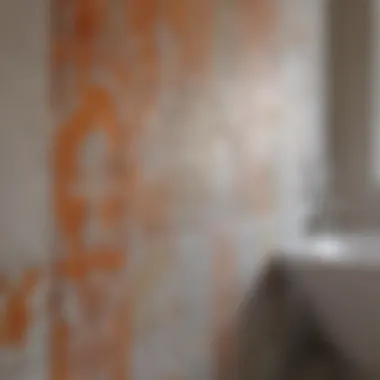
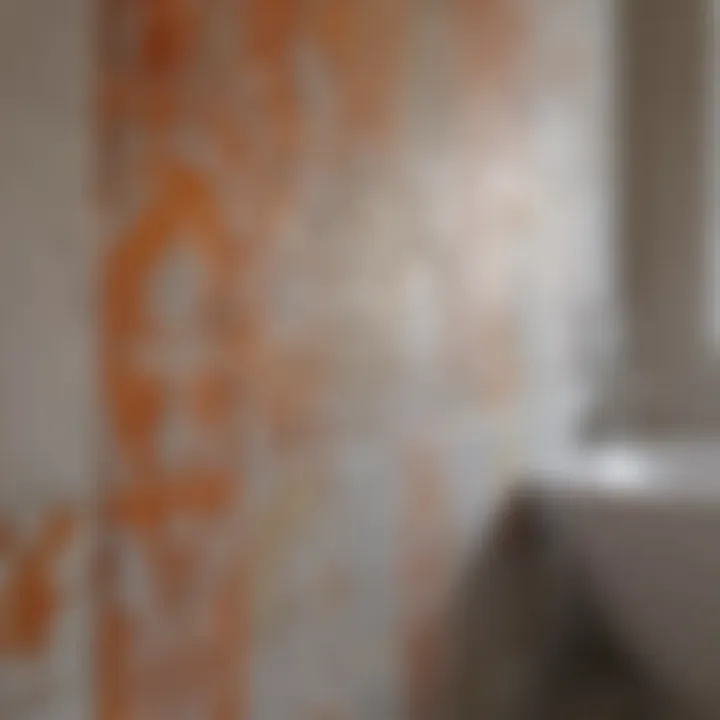
Glass tiles add a modern touch and reflect light beautifully, creating the illusion of a larger space. Their non-porous nature means they are highly resistant to moisture, but they do present a challenge when it comes to painting. The shiny surface can hinder paint adhesion, often requiring a special primer designed for non-porous surfaces. It's crucial to select paints that are compatible with glass to ensure a smooth finish that adheres effectively.
Understanding these characteristics and types of bathroom tiles allows for strategic planning when selecting paints. This foundation aids in enhancing the beauty and functionality of bathrooms while minimizing potential mishaps that can arise from incompatible materials.
Evaluating Paint Options
When it comes to painting bathroom tiles, the choice of paint can feel like finding a needle in a haystack. In this section, we’ll delve into the various paint options available, each with its own set of characteristics that can make a significant difference in how the final result looks and performs.
Selecting the right paint is more than just about choosing a color. It's about durability, water resistance, application ease, and the finish you desire. With moisture being a constant presence in bathrooms, understanding the benefits of various paint types will help ensure that the results not only look good but also stand up to the daily wear and tear. Let's take a closer look at the different options to help you make informed decisions.
Acrylic Paints
Acrylic paints are a popular choice thanks to their ease of use and versatility. They offer a good balance of flexibility and durability, making them suitable for components in humid environments like bathrooms. Here are some reasons why acrylic is a paint worth considering:
- Water-Based: Being water-based means they dry quickly and have less odor compared to oil-based paints. This is an advantage if you’re planning on working in a confined space.
- Flexible Finish: Acrylic paints provide a somewhat flexible coating, which helps prevent cracking when tiles expand and contract due to changes in temperature.
- Color Variety: They come in a vast array of colors, allowing homeowners to customize their designs easily.
Despite the pluses, it’s worth noting that acrylics may not be as resistant to scratches or stains as other types, so it's essential to choose quality brands for the best outcome.
Epoxy Paints
If you’re after durability, look no further than epoxy paints. These are often recommended for tiling in areas that experience high moisture levels and require robust protection. Take a look at the benefits of epoxy paints:
- High Durability: Epoxy paints bond well to surfaces and form a hard shell that can withstand intense wear and tear.
- Moisture Resistance: They stand up exceptionally well to moisture, making them ideal for bathrooms where water exposure is inevitable.
- Easy to Clean: This type of paint tends to be easy to clean, resisting staining from common bathroom substances like soap and toothpaste.
On the flip side, the application process for epoxy can be more complex. It usually requires mixing components and may necessitate professional installation for the best results.
Specialized Tile Paints
Finally, don't overlook specialized tile paints. These options are tailored specifically for tile surfaces and tend to have formulations that promote strong adhesion and resistance to moisture. Here’s what makes these paints unique:
- Tailored Formulations: They usually contain additives that make them suitable for tile surfaces, enhancing bonding and durability.
- Variety of Finishes: Many specialized tile paints come in several finishes, from glossy to matte, allowing for a custom look that fits your style.
- Self-Leveling Properties: Some of these paints feature self-leveling properties, which help to create an even finish, minimizing visible brush marks or unevenness.
While specialized tile paints can be a bit pricier than standard options, the benefits often outweigh the costs when it comes to longevity and aesthetic appeal.
Remember: Choosing the right paint may seem overwhelming, but focusing on the specific needs of your bathroom can help clarify the best options for your project.
Key Considerations for Selection
Choosing the right paint for bathroom tiles isn't just a matter of picking a pretty color. It's a decision that hinges on several crucial factors, each contributing to the long-term success of your painting project. Selecting the right paint can ensure that your tiles remain vibrant, withstand the rigors of a moist environment, and ultimately simplify the upkeep of your bathroom.
- Durability and Longevity
One of the most significant aspects of paint selection is durability. Bathroom tiles are hit with a unique combination of elements—moisture, heat, and frequent cleaning. Therefore, it’s vital to choose paints that boast excellent adhesion and resilience against these factors. Resilient paints can protect your tiles from scratches and wear. It’s also essential to understand that cheaper paints may save you a few bucks now but could lead to peeling or fading down the road, costing you much more in repairs. So, invest in quality; it tends to pay off in the long run. - Moisture Resistance
Bathrooms are notorious for high humidity. Selecting paint that can handle this dampness is imperative. A moisture-resistant paint will not only shield the tiles but also keep mold and mildew at bay. Some paints are treated specifically for moisture control, which can make a world of difference. When reading product labels, don’t hesitate to look for terms like ‘waterproof’ or ‘mold-resistant.’ This will save you from a messy bathroom nightmare later on. - Ease of Application
Not everyone is a paint pro, and that’s perfectly alright. When selecting a paint, consider how simple it is to apply. Some paints come ready to use, eliminating the need for complicated mixing or extensive prep work. Look for paints that offer user-friendly application options, such as easy rolling or spraying. This makes a tedious job much more manageable and significantly boosts the chances of achieving a flawless finish. Keep in mind that the easier the application, the less room for mistakes—now who wouldn't want that?
"Selecting the right paint for your bathroom tiles is not just an aesthetic choice; it’s an investment in durability, maintenance, and overall bathroom hygiene."
In summary, when it comes to painting bathroom tiles, focusing on durability, moisture resistance, and ease of application is key to ensuring a successful and lasting transformation. Armed with the right information, you'll be better prepared to make informed choices that elevate the look and feel of your bathroom without breaking the bank—now that's a win-win!
Preparation Before Painting
Preparation is the unsung hero in any painting project, especially when it comes to bathroom tiles. Ensuring your tiles are ready to accept paint is crucial to achieving a finish that not only looks great but will also endure the test of time. If you jump straight into the painting without appropriate prep work, you may find yourself facing peeling or chipping paint down the line, which can be a right headache.
The first step is cleaning the tile surface adequately and addressing any imperfections before you even consider picking up a brush. This step is not just a mere formality; it’s foundational. Effective cleaning eliminates dirt, grime, and soap scum, creating a clean slate that helps the paint adhere properly.
Next up, priming is a game-changer. Think of it like putting on a nice outfit before going out; it sets the tone. A good primer creates a bond between the tile and paint, enhancing durability and providing an even surface to paint on. It’s an extra layer of insurance that can prolong the life of your freshly painted tiles, keeping them looking impeccable for as long as possible.
Key Considerations:
- Dedication to preparation can save time and effort down the line.
- It reduces the likelihood of paint failure.
- Increases paint durability and longevity.
- It helps you achieve a professional-looking finish.
"Failing to prepare is preparing to fail."
By taking these considerations to heart and investing time in preparation, you’ll be setting yourself up for success and ensuring that the application process is as smooth as silk.
Cleaning the Tile Surface
Cleaning the tile surface is a non-negotiable step. It may seem mundane, but believe me, it’s where most paint jobs either soar or stumble. Begin by gathering necessary supplies: a stiff-bristle brush, a bucket, and a suitable cleaning solution. A simple mix of warm water and vinegar can work wonders, cutting through soap scum and mildew effectively.
- Scrub Away Dirt: Use the stiff-bristle brush to scrub the tiles thoroughly. Pay attention to grout lines and corners, as these areas often accumulate stubborn dirt.
- Rinse Well: After scrubbing, rinse the tiles with clean water to remove any residual dirt and cleaning solution. It’s vital that no soap remains, as it can interfere with adhesion.
- Dry the Surface: Let the tiles dry completely. This can take time, so be patient. If you don’t let them dry, you might end up with water trapped under the paint, which can lead to peeling later on.
In case there are stubborn stains that just won’t budge, a small amount of baking soda mixed into your cleaning solution can act as an extra abrasive without scratching the tile.
Priming the Tiles

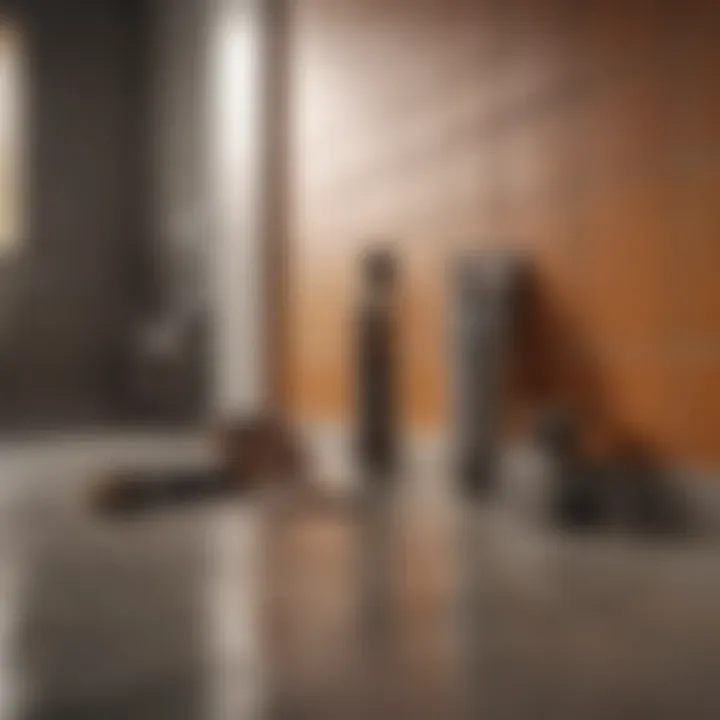
Alright, so your tiles are all clean and dry, now what? Time to roll up your sleeves and get to priming. Priming might seem like an optional phase, but make no mistake, it’s essential.
Applying a primer will ensure that the paint adheres better and lasts longer. Here’s how to tackle this:
- Select the Right Primer: Choose a primer that’s compatible with the type of paint you’ll be using. For example, if you opt for specialized tile paints, look for a primer specially designed for tiles.
- Application: Use a high-quality brush or roller for even coverage. Apply a thin layer, smoothing it out across the tiles. Let it dry according to the manufacturer’s instructions. This step is crucial—don’t rush it!
- Check for Even Coverage: After drying, inspect the tiles for any missed spots or uneven areas. If needed, apply another coat to ensure full coverage.
By ensuring a sturdy base with a proper primer, you’ll drastically enhance the adhesion of the paint and fine-tune your bathroom’s appearance. So take this step seriously—your future self will thank you!
Application Techniques
Choosing the right application technique for painting bathroom tiles significantly shapes the final result. Each method offers distinct advantages and considerations that can affect not just the aesthetic appeal, but also the durability of the paint job. An effective application can ensure smooth coverage, reduce the risk of errors, and extend the life of the paint. Let's explore the main techniques that can help achieve a flawless finish.
Brush Application Method
Using a brush for painting bathroom tiles is a traditional method that allows for precision. This technique is particularly useful in detailed areas, like edges and corners, where rollers might not be able to reach effectively. When you tackle a brush application, take time choosing the right type of brush. A synthetic bristle brush works well with water-based paints, while a natural bristle brush is ideal for oil-based paints. This choice matters, as it directly influences the coverage and finish quality.
Pros of using a brush include:
- Control: You can maneuver easily around intricate patterns and edges.
- Detailing: It allows for careful detailing around fixtures and moulding.
However, brush application can also come with some drawbacks:
- Texture Issues: It may leave visible brush strokes if not done carefully.
- Time-Consuming: This technique can take longer, especially for large surface areas.
Roller Application Method
If you're looking for efficiency and a smooth finish, roller application might be your best bet. Rollers cover large surfaces more rapidly compared to brushes, making them ideal for expansive tile areas. The key to a successful roller application lies in selecting the appropriate nap length, which affects the texture of the finish. A smooth surface generally requires a short nap, while a thicker nap is better suited for textured tiles.
Some benefits of roller application include:
- Speed: Quick application, saving you valuable time.
- Reduced Strokes: Fewer strokes can lead to a more uniform coat and a more professional appearance.
But keep the following in mind:
- Edge Detailing: You’ll still need a brush for detailed edges, which adds an extra step.
- Texture: If not applied properly, it may trap paint in tile grooves, leading to an uneven finish.
Spray Application Method
For those seeking a factory-like finish, spray application is worth considering. This technique is favored by professionals for good reason: it provides an even coat that minimizes brush strokes and roller marks. It's also excellent for reaching intricate areas or tight spots that other methods struggle with. However, spray application does come with its set of challenges.
Benefits of using a spray application method are:
- Even Coverage: Achieves a flawless finish across all surfaces.
- Speed: Allows coverage of large areas in a fraction of the time.
Conversely, you'll also face some challenges:
- Preparation Required: Extensive preparation is needed to protect surrounding surfaces from overspray.
- Skill Level: Requires some practice and skill to master techniques and adjust spray settings.
Using the right spray equipment and practicing can alleviate many issues associated with this technique.
Post-Painting Maintenance
Maintaining a freshly painted tile surface is vital for preserving both its aesthetic appeal and long-term durability. After the paint has settled and the scents have faded, your job isn’t quite done just yet. The post-painting period involves a series of steps which, if carried out effectively, can greatly enhance the lifespan and look of your newly painted tiles. Here are the specific elements, benefits, and considerations regarding post-painting maintenance that every homeowner should keep in mind.
Cleaning and Care Regimens
Keeping those tiles clean isn’t just a chore, it’s a necessity. A proper cleaning regimen helps in retaining the beauty of the finish and also keeps issues like mold and mildew at bay. Here’s how to do it:
- Wait Before You Start: After painting, give your tiles ample time to cure. Depending on the type of paint used, this could range from a few days to weeks. Check your paint's instructions thoroughly for guidance.
- Gentle Cleaning Solutions: Opt for mild soap or a gentle pH-balanced cleaner. Avoid harsh chemicals like bleach or ammonia, as these can strip the paint off or discolor the tiles.
- Soft Cloths: Use soft sponges or cloths to wipe the surface, ensuring you don’t scratch the new paint. It’s like handling a newborn! Gentle touches are key.
- Regular Maintenance: Just like a well-tended garden, your painted tiles need regular cleaning. Make it a habit to wipe down the tiles weekly to remove any dust or soil that can accumulate.
"Routine maintenance is akin to preventative medicine for your painted tiles. A little care goes a long way!"
In terms of benefits, adhering to a proper cleaning regimen can prevent dirt buildup and maintain the vibrant color of the paint, keeping your bathroom looking sharp and inviting.
Repairing Chips and Scratches
Reality check: Chips and scratches can happen, no matter how careful you are. Addressing these small imperfections swiftly can stop them from becoming a bigger headache. Here’s the lowdown on how to tackle them:
- Assess the Damage: Before commencing repairs, take stock of what you’re dealing with. Minor scratches may require little more than a touch-up, while chips could need extra attention.
- Gather Supplies: You’ll need paint that matches your original coating, a small brush for precision, and a fine-grit sandpaper if you’re dealing with uneven edges around the chip.
- Touch-Up Technique:
- Patience Is Key: Allow each layer to dry completely before applying another coat to avoid clumping or uneven surfaces.
- Regular Monitoring: From time to time, keep an eye out for new chips or scratches. Quick fixes are easier and more effective than letting the problem escalate.
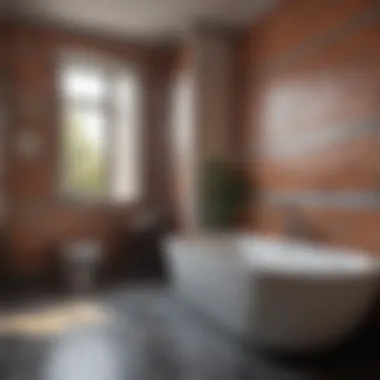
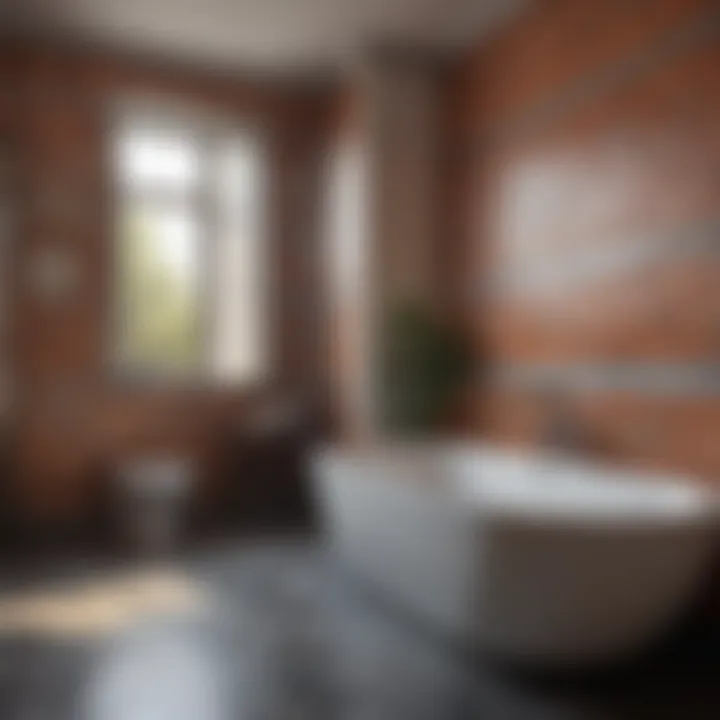
- For scratches, apply a thin layer of the matching paint directly onto the affected area. Use a small brush to blend it well, ensuring there’s no harsh outline.
- For chips, lightly sand around the edge to create a smooth surface. Once that’s done, paint in the area, being sure to feather it out to merge with the surrounding tile.
In summary, both cleaning and repairing are pivotal elements of post-painting maintenance. They not only prolong the life of your paint and tile but also contribute to a sanitary and attractive bathroom environment. Owning the upkeep of your painted tiles reflects a commitment to quality and aesthetics, transforming your space into the sanctuary you deserve.
Common Challenges
When embarking on the journey of painting bathroom tiles, it's crucial to be aware of common challenges that may arise. These hurdles can impact not only the aesthetics of the space but also the longevity of your paint job. Addressing these issues proactively allows homeowners to achieve beautiful results that stand the test of time. Let's take a closer look at the specific difficulties you might face and how to navigate them with ease.
Peeling and Chipping Paint
One of the most frustrating outcomes of painting tiles is peeling and chipping. This issue often stems from inadequate surface preparation or using the wrong kind of paint. Tiles are typically smooth and glossy, which means if they're not properly cleaned and primed, the paint might struggle to adhere. Imagine spending hours painting, only to watch it flake off like old wallpaper months later.
- Poor adhesion is often caused by not cleaning the tiles thoroughly. Dirt, soap scum, and moisture can create a barrier, preventing the paint from sticking well. A good rule of thumb is to clean with a solution of vinegar and water before applying primer.
- Using the wrong paint can also lead to peeling. Not all paints are suited for wet environments. Choosing a specialized tile paint or epoxy can ensure proper adherence in the bathroom setting.
In short, while peeling and chipping may feel daunting, understanding the causes can help you take preventive steps, ultimately leading to a more successful, longer-lasting finish.
Moisture Accumulation Issues
Bathrooms are notorious for their high-moisture environments, which can create a breeding ground for problems. Over time, paint in the bathroom may begin to bubble or warp due to excess moisture.
- Trapped moisture happens when the humidity level rises, particularly after a hot shower. If the paint isn't moisture-resistant, it can lead to peeling or even mold growth, a scenario nobody wants.
- To tackle this challenge, consider investing in moisture-resistant paints that are designed specifically for bathrooms. These types of paints have properties that help them withstand dampness, reducing the risk of mold and mildew.
Ventilation also plays a significant role in managing moisture levels. Ensure your bathroom has adequate ventilation, such as an exhaust fan, which can significantly reduce humidity after a shower or bath.
Achieving a Uniform Finish
There’s nothing worse than a patchy or uneven paint job, especially in a place as prominently used as the bathroom. Achieving a uniform finish can be a tough nut to crack, but with the right approach, it’s perfectly possible.
- One problem could be applying too much or too little paint at once. Different tiles may absorb the paint differently, leading to inconsistencies. Using a roller application method tends to provide a more even coat compared to a brush. This avoids brush marks and makes the process quicker.
- To ensure an even application, consider using a color sample on a small area first. This allows you to see how the paint interacts with the surface and the light in the bathroom. Plus, it helps to avoid any nasty surprises later on.
- Lastly, consider applying two to three thin coats instead of one thick one. Allow adequate drying time between coats. This technique helps achieve a more uniform look without the dreaded drips or uneven patches.
In summary, understanding the potential pitfalls when painting bathroom tiles can save you time, effort, and money in the long run. It’s about making informed choices that uplift your space and withstand the rigors of a high-moisture environment.
Innovative Products on the Market
When it comes to painting bathroom tiles, keeping up with the latest innovative products can make a world of difference. These advances not only improve the quality of your paint but also address specific concerns that often plague bathroom environments. From moisture to durability, innovative products tailored specifically for tile applications are becoming increasingly critical for both DIY enthusiasts and seasoned renovators.
The benefits of these cutting-edge products span across several dimensions, such as enhanced performance, aesthetic appeal, and environmental consciousness. As homeowners embark on their bathroom tile projects, seeking out these modern solutions will ultimately lead to more satisfying and lasting results.
Eco-Friendly Paint Options
In today’s eco-aware world, many are looking to minimize their environmental impact, and eco-friendly paint options are a solid choice. Traditional paints often contain volatile organic compounds (VOCs) that can be harmful not only to our health but also to the environment. Eco-friendly paints offer alternatives that are low or zero VOC, making them safer for residential use.
Choosing eco-friendly paint means you can have peace of mind while you transform your bathroom. These paints do not compromise on quality despite being formulated with fewer harmful chemicals. Here are a few points to consider:
- Safety First: Reduced VOCs mean better air quality, especially in areas like bathrooms, where ventilation can be limited.
- Sustainability: Many eco-friendly options use sustainable ingredients and manufacturing processes, making them a better choice for the planet.
- Long-lasting: These paints often provide excellent durability, resisting peeling and chipping while maintaining their vibrant color for years.
By opting for eco-friendly paints, you’re not just enhancing the beauty of your bathroom tiles; you’re also contributing to a healthier living space and a cleaner environment.
Rapid-Dry Formulations
Another noteworthy innovation is the introduction of rapid-dry formulations. For anyone who has ever attempted to paint bathroom tiles, waiting forever for paint to dry can be a real pain. Rapid-dry paints allow for much quicker turnaround times, letting you finish your project and enjoy the results sooner.
The perks of these formulations don't just end at speed:
- Efficiency: Less time waiting for paint to dry means more time to move on to other tasks or projects.
- Multiple Coats: With faster drying times, applying multiple coats in one day is feasible, ensuring better coverage and finish in a shorter period.
- Less Dust and Debris: With shorter drying times, there’s reduced risk of dust or particles settling onto the paint surface, leading to a smoother finish.
Investing in rapid-dry paint formulations can significantly streamline your bathroom tile project, allowing you to enjoy your handiwork without the tiresome wait.
"In a world that moves fast, having paint that dries faster could transform an all-day task into a quick afternoon project."
Ultimately, keeping abreast of innovative products on the market can lead to transformative results in your bathroom tile painting endeavor. Focusing on eco-friendly options and rapid-dry formulations can bring both beauty and practicality into your home, ensuring that your bathroom is not only visually pleasing but also aligned with contemporary needs.
Final Thoughts
In wrapping up this exploration into the world of tile painting, it's clear that selecting the right paint for your bathroom tiles isn't merely a matter of picking a pretty color. It's about harmonizing aesthetics, functionality, and longevity. Each choice you make reverberates through the durability of your tiles and the overall feel of your bathroom space.
Summarizing the Essentials
When considering the insights shared in this article, remember the essentials:
- Understand Tile Surfaces: Know the characteristics that define your tiles, whether porcelain, ceramic, or natural stone. Each type responds differently to paint, requiring unique preparations.
- Evaluate Paint Options Thoroughly: Don’t rush into a decision. Weigh the pros and cons of acrylic, epoxy, and specialized tile paints. Each has its merits and ideal application scenarios.
- Prioritize Key Factors: Durability, moisture resistance, and ease of application are paramount. Investing time to assess these elements pays off long-term.
- Prepare Diligently: The preparation phase sets the stage for your success. Cleaning and priming are non-negotiables.
- Employ Proper Techniques: The method of application matters. Whether you're using a brush, roller, or spray, mastering the techniques ensures a flawless finish.
- Address Common Challenges: Being aware of potential pitfalls—like peeling paint or moisture issues—armors you against common frustrations.
Looking to the Future of Tile Painting
As we gaze into the horizon of home improvements, the landscape of tile painting continues to evolve. Innovations in paint technology and eco-friendly materials are reshaping how we approach our projects.
- Sustainability Trends: Homeowners are increasingly leaning towards sustainable living. It’s crucial to consider paints that are not only safe for the environment but also for the health of those within the home. Expect to see more options that are low in volatile organic compounds, promoting a healthier indoor atmosphere.
- Technological Advancements: Future products are likely to showcase rapid-dry and self-leveling formulas, making the application process faster and easier. Imagine completing a project in hours rather than days!
- Customization and Aesthetics: With advancements come opportunities for greater personalization. Look forward to a wider palette of colors and finishes tailored to the unique tastes of individual homeowners, ensuring that even the smallest of bathrooms can make a big statement.







